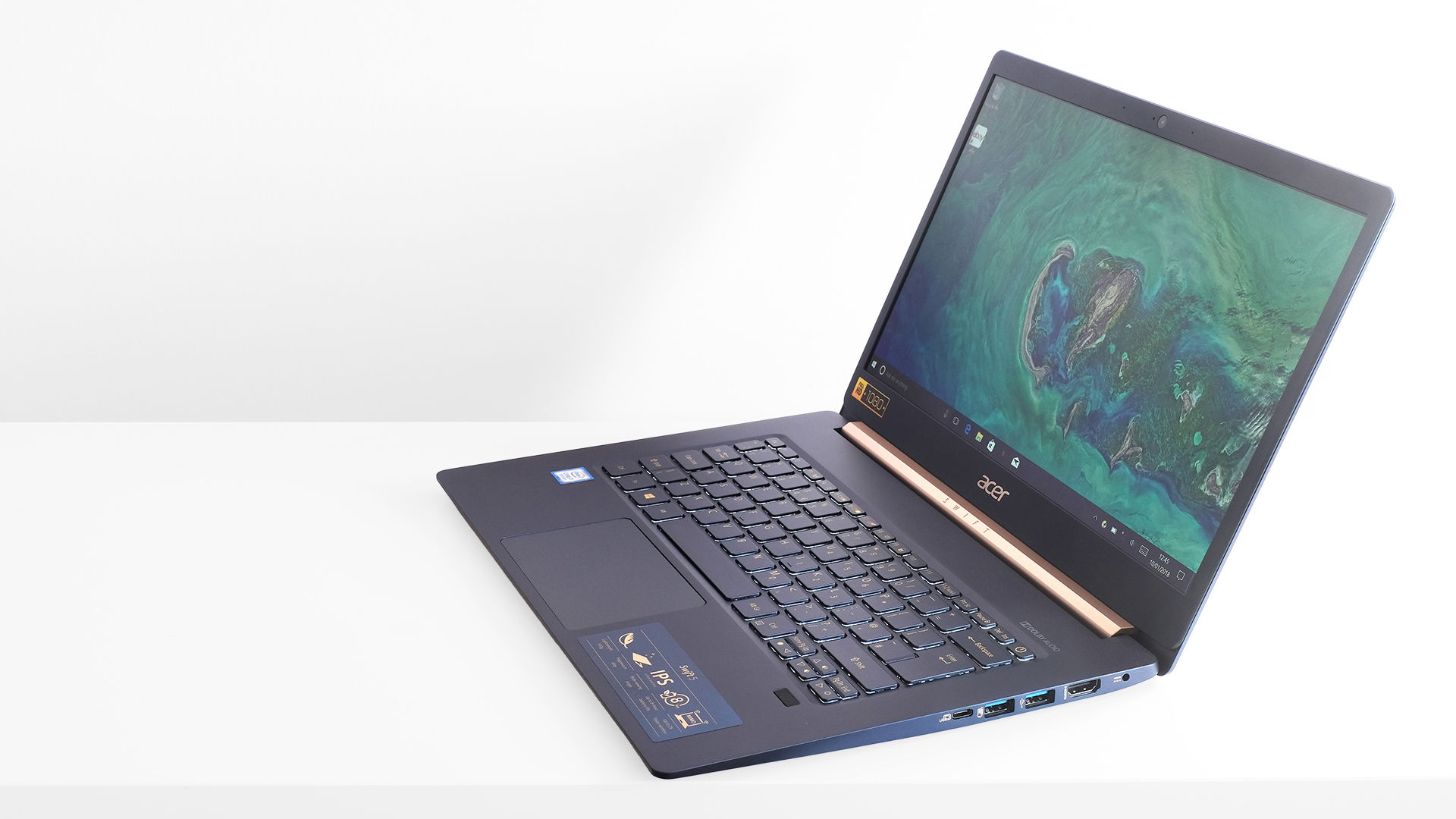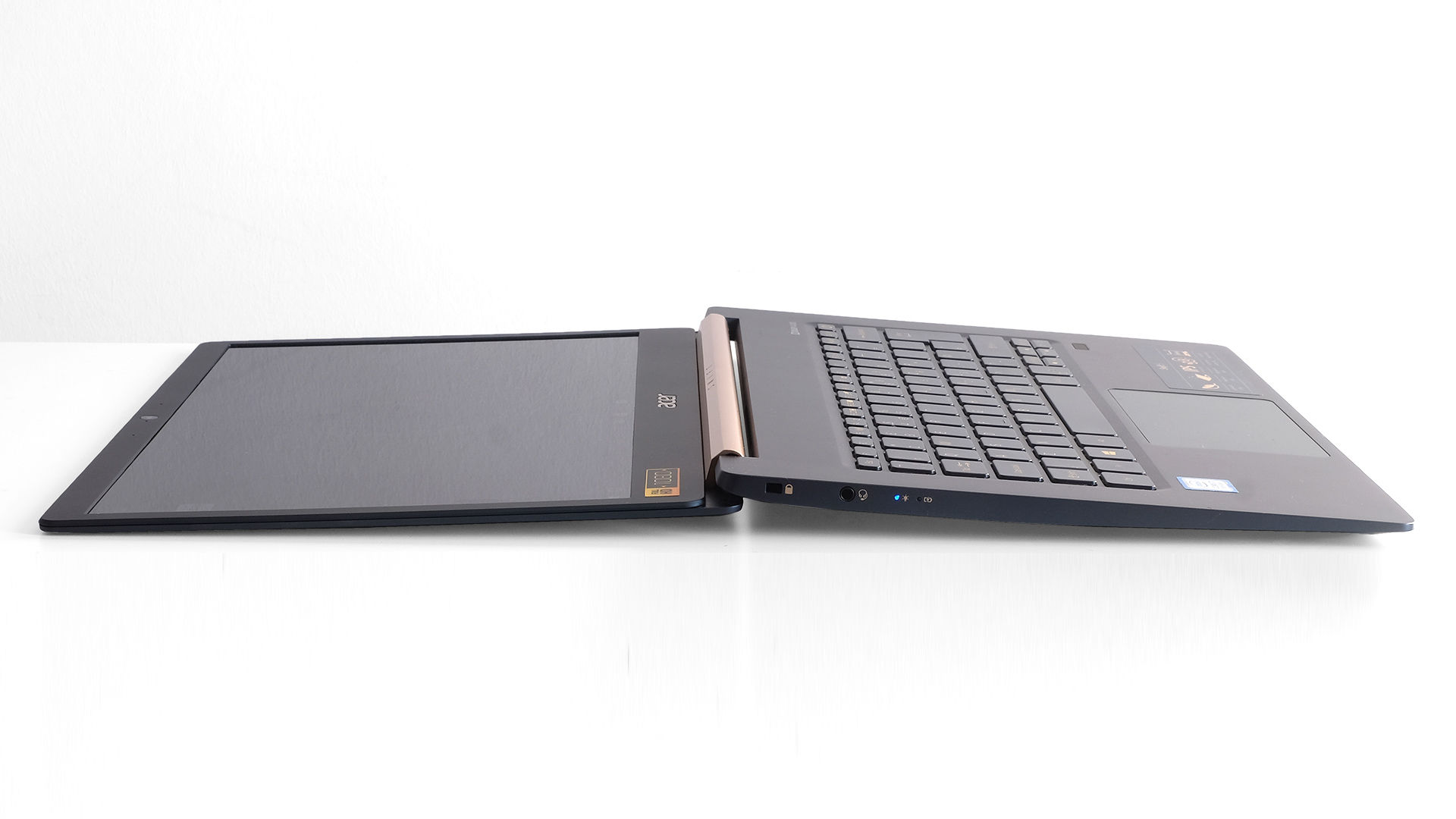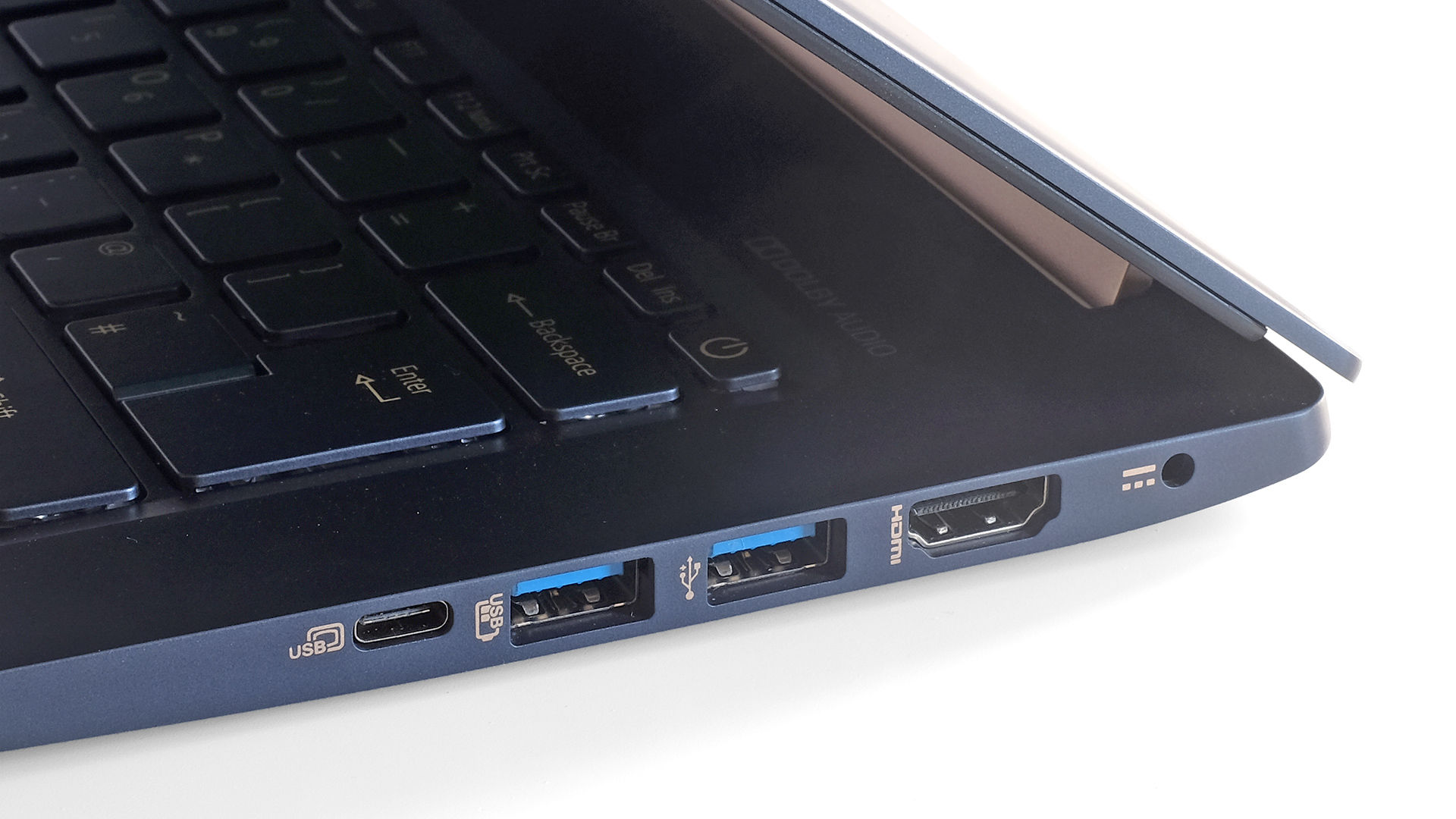That’s not the lone appeal, though. £300 cheaper than several laptops with similar specs, it has the value factor that has seen us recommend several Acer models over the last 18 months. There are trade-offs: the Acer Swift 5 starts to sound like a toy jet aeroplane under the light pressure and alternatives last longer between charges. However, it’s so alarmingly light and well-priced this is still a top choice for those who have to carry their laptop around 24/7. Your shoulders will thank you.
Price and availability
You need to be careful when shopping for the Swift 5, at the time of review at least. The version we’re reviewing is the Acer Swift 5 SF514-52T. That link leads to the i5 version, but ours had an 8th generation Core i7 CPU, 256GB SSD and 8GB DDR3 RAM. It’s hard to find though, so the Core i5 model – which is enough for most people – has an RRP of £899. The Swift 5 comes with a one-year “carry-in” warranty, where you have to arrange getting your laptop to a service centre.
Design and build
The secret to the Acer Swift 5’s amazing low weight can be summed up in one word: magnesium. Where most premium laptops are made using aluminium, this shell is a magnesium alloy. Magnesium is stronger than aluminium, but doesn’t feel immediately as impressive. And this, perhaps more than anything other reason, is why aluminium is so popular in phones and laptops. Magnesium is not as cold to the touch, and some even mistake it for plastic at first. However, it remains an excellent material for a laptop shell, and has been used by some very high-profile models including the Microsoft Surface Pro. Magnesium brings the Acer Swift 5’s weight down to 970g, which is 400g lighter than the last Swift 5 we reviewed, and around the same amount lighter than other obvious competitors like the Dell XPS 13. We tend to downplay the importance of superlative specs and Top Trumps-style weight rivalries, but you can immediately notice the difference here. Some may find this worrying initially: if it’s this light, there must be something wrong? However, the main panels of the Swift 5 are stiff, and the laptop looks good. The style is two-tone. Most of the shell is dark blue, and there are gold hints throughout, including the inner part of the hinge. Perhaps surprising, the Swift 5 isn’t radically slim as well as radically light, though. A shade under 15mm thick, it’s almost 50% thicker than the HP Spectre 13, but that laptop is also slightly heavier and a lot more expensive. You need to stretch to the Swift 7 to get thin-ness too: it’s 8.98mm thick, slimmer than some phones. And that’s just showing off.
Connectivity
Ultra-slim laptops tend to be the most aggressively forward-looking in terms of their connections. Often annoyingly so. However, the Acer Swift 5 takes a more old-school approach that should please a lot of you. There are two USB 3.0 ports, the full-size kind, and a full-fat HDMI socket on the right side. You can just plug your peripherals in, no need for adapters. The Acer Swift 5 also has a single USB-C port, although it’s the standard USB 3.1 Gen 1 kind, not an ultra-fast Thunderbolt 3 connector. As the Swift 5 uses a separate cylindrical power socket, none of the connections are “used up” while charging. The obvious missing part is a memory card slot. You’ll need to carry around a USB card reader if you plug-in a microSD or SD card regularly.
Keyboard and trackpad
The Swift 5 doesn’t quite have the best keyboard and trackpad in this slim and light class. But each does its job well enough. Its keyboard is light, the action on the soft side. However, there is a backlight, keys are well-spaced and there are no obvious layout issues to worry about. The magnesium frame also makes the keyboard stiff, with very little flex. Too much can ruin the feel of a keyboard, and it’s an issue in some Asus rivals. It’s a quality keyboard, if not quite Acer’s best. The trackpad below has a plastic surface, but one that feels almost bafflingly close to the more desirable textured glass. There’s none of the squeakiness of some plastic pads, and the click action is comfortable enough, if on the stiff side. Just about the trackpad sits a small fingerprint scanner. It looks like one of the old kind of “swipe” scanners, once common in business laptops, but is actually just a normal static pad on which you rest a finger to login using Windows 10’s Hello feature. It’s a passable scanner, but not among the best. Rather wide, you need to be careful about finger placement to cover the entire pad, which is required to make it function. You may need a few attempts to login.
Screen
The Acer Swift 5 has a 14in 1080p IPS LCD screen. This is what we’re after in a sub-£1000 portable laptop. Most higher-resolution laptops cost more these days. It’s a rich-looking display whose only issue is limited top brightness. 255cd/m really isn’t all that bright. And as the finish is glossy, reflections are also an issue outdoors. This is an important problem considering the Swift 5 is a “take me anywhere” laptop. This screen has very good colour reproduction for the price, covering 90.8% of the sRGB standard. In some shades it even exceeds this standard too, with 102.1% coverage (by volume) when these are included. A year or so ago laptops like this tended to hit around 75-85% of sRGB, and creeping above 90% is worth celebrating if you’re picky about colour saturation. For those interested in the deeper colour gamuts, the Swift 5 covers 66.4% of Adobe RGB and 71.4% of DCI P3. Contrast too is superb for an LCD at 1467:1, and the Swift 5’s screen tilts just a smidge over 180 degrees, offering plenty of flexibility for a standard, non-hybrid, non-touchscreen laptop. The display fares better in the home than out in the park on a summery day, but does look great indoors.
Performance
The Swift 5 has as much power as some laptops costing £1499. It uses the Intel Core i7-8550U processor, a quad-core chipset with a clock speed of 1.8GHz and a Turbo clock speed of 4GHz. If you’re upgrading from a 7th Gen CPU or, more likely, an older one, the raw performance difference is huge. Fitting four cores into such a small chipset has allowed Intel to squeeze in the sort of power we only used to get from chunky 3kg workstations. Of course, general Windows performance will actually be similar to that of any recent Core-series laptop. This “bonus” power doesn’t really come into effect if you’re browsing Facebook, funnily enough. The Swift 5 has a 256GB SSD, which is again a good level for the price, and far more comfortable than a 128GB drive, a lot of which would be eaten up by Windows 10. This is not a fast SSD, though, and this is one of the ways Acer has kept the price competitive. It reads at 557MB/s and writes 264MB/s: 2-5 times faster than a “spinning platter” hard drive, but some are several times as quick. Read speeds of 1300MB/s are common with higher-end SSDs. Again, this isn’t something that becomes obvious in normal use, just when handling very large amounts of data. At the time of writing, in January 2018, we’re in a funny old place for laptop performance. CPU vulnerabilities dubbed “Meltdown” and “Spectre” have prompted system updates that reportedly have a marked effect on performance. Our Acer Swift 5 arrived without these applied so we’ve been able to test both pre and post the update. Pre-update, it scores 13606 in Geekbench 4, almost double what you’d see from a laptop with a last-generation Core i7 CPU. Fully updated we saw virtually identical scores: 13672 points. It could be that Windows 10 sneaked-in a quick forced update we didn’t notice, but performance is still far better than any slim Core i7 laptop from the last generation. However, the Lenovo Yoga 920 did do better, with a score of 14423. The Core i7 version of that laptop also costs £1349, though. It’s significantly more expensive. In PC Mark 10 it scores 3374, roughly matching the recently reviewed HP Spectre 13 x360 (3422 points). Despite the low weight, this is a good performer that can handle demanding apps. Intel’s 8th Generation improvements are all about the CPU side, not the integrated GPU, so gaming performance is not significantly better than last year’s models. Alien: Isolation runs at an average 34fps at 720p resolution, Low settings, which we’d call comfortably playable if not ideal. That drops to 14fps at 1080p with all the effects turned back on. And that’s too juddery for our tastes. A more demanding game like Deus Ex: Mankind Divided is a step too far for the Swift 5, averaging 14fps at 720p (Low settings) and 3.5fps at 1080p, Ultra settings. You can play older games just fine, and some from the last five years if you drop the resolution and simplify the graphics. However, there are better options for keen gamers. Right now some of these haven’t made the leap to 8th Gen CPUs, but something like the £949 HP Envy 13 with GeForce MX 150 graphics will play games more smoothly. It’s also 400g heavier, so it’s time to consider what your top priorities are. One aspect of the Swift 5 you’re likely to notice during the first few days is the fan. While this laptop will stay silent if you simply write a document, the fan kicks-in very early. Just transferring files to the SSD from an external drive or installing an application can make it start spinning, and it has the classic sound of a fan with a small diameter. The pitch is high and the fan sounds like it’s working fairly hard whenever it spins. Those who’ll use the Swift 5 in a quiet room or office may find it distracting. This is slightly disappointing when some laptops that are the same size (if significantly heavier) have less noticeable fan noise. Thinking about this a little more, Asus may have used smaller heatsinks here to further reduce weight, making the air-shifting properties of the fan all the more important.
Battery Life
The battery has also been sacrificed to get below 1kg. Where the old Swift 5 had a 53.9Wh battery and lasted a solid 10.5 hours in the video playback test we put all our laptops through, the new model has a smaller 36Wh unit. It’s another reminder you don’t get a laptop this light for “free”. Playing a 720p movie on loop at 120cd/m brightness, the Acer Swift 5 lasts just six hours 36 minutes, which is roughly commensurate with the decrease in capacity since the last model in this series. It wouldn’t last a full day’s work, and that would be a problem for us. Make sure it isn’t for you before buying.








